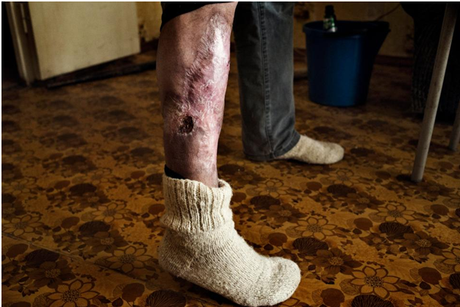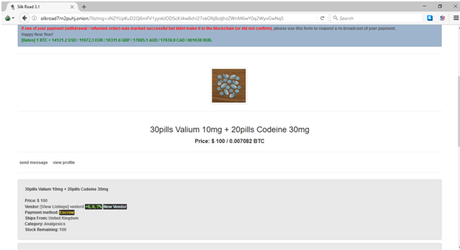Key details surrounding the discovery of Krokodil are as surreal as the health implications of consuming the drug.
In 2002, Russian health centers began making reports of the characteristic occurrence of bizarre physical derangements on patients battling drug abuse.
These strange observations were recorded as patterns involving people whose flesh would develop gangrene and scales that typify anatomies of members in the reptilian family.
Siberian health centers made discoveries about the new drug that junkies were pumping into their bodies, "Krokodil".
Why the Name Krokodil?
Krokodil derives its name from the physical effects suffered by users of the drug. This narcotic causes skin lesions that make the addict's skin to resemble that of a crocodile. The scales and bumps are produced when a user develops skin abscesses owing to the difficulty of administering the drug to their systems.
Specifically, an abscess is formed in muscle tissue when a user misses a vein during the injection process. The occurrence of the poisonous substance within the flesh causes it to rot from the inside out, usually leading to the amputation of the victim's limb. It is common to encounter instances of severe body part degeneration that would even expos the bare bone.

Figure 1: The characteristic scaly skin and gangrene caused by Krokodil usage(Image: Emanuele Satolli)
What is Krokodil?
Krokodil is a "rogue" form of desomorphine. The costs and ease of manufacturing Krokodil pose a problem in controlling its popularity. The drug can be easily created by junkies at home. An addict may easily "cook" it from the comfort of their den by using simple ingredients obtained over the counter.
Pharmacies and hardware outlets are known to be the best sources of elements used in creating this behemoth. Codeine itself, a key ingredient, can be obtained easily from chemists. As of yet, many nations of the world have not restricted over-the-counter purchases of codeine by regular citizens.
Codeine is usually combined with other chemicals to create the ultimate power punch. Red phosphorus, hydrochloric acid, and thinners form part of the Krokodil cooking process. The resultant substance is yellow and has a characteristic acrid stench.
Deadly Ingredients
Essentially, desomorphine is an opioid that was medically developed to suppress pain. Krokodil is laden with impurities that stimulate the eruption of body disorders. The cooking process used to produce this drug fails to eliminate the toxic byproducts derived from its synthesis.
Cooking releases iodine and phosphorous, both of which are known to be toxic when injected directly into human flesh. The solvent requirements of the cooking process prompt junkies to use impure solvents as a cheap way to make the desired dose.
Gasoline is used as a solvent when creating the substance, and users often fail to effectively eliminate this substance before administering the final product to their bodies.
The hydrochloric acid applied in the manufacturing process usually contributes to the final pH level of the end product, which would have very high acidity. Hydrochloric acid is the main culprit blamed for causing Krokodil's adverse skin irritation that predisposes the user to gangrene.
Additional toxicity is also begotten by the failure to eliminate and dispose of the insoluble substances forming the chemistry of codeine tablets. There is no adequate explanation for the extent of damage caused by Krokodil's ingredients on users' bodies, minds and souls.
Krokodil's Cost and Availability on Darknet Markets
Krokodil is relatively cheap when compared to Heroin. In Europe, the price of Krokodil is marked at only a few dollars (as low as $8), whereas heroin is about $20 per dose.
Krokodil is also cheaply produced since the drug formulation does not require complicated mechanisms for production. In the drug world, Krokodil is embraced as a cheap alternative to heroin.
Darknet markets have long been known to be ample platforms for the online sale of illicit drugs. To date, few significant sites dominate the drug trafficking market share. Dream Market is considered as one of the most significant marketplaces for trading drugs.
Vendors on this darknet market trade all manner of substances, excludingKrokodilwhich is largely missing from its searches.
Silk Road is another popular darknet marketplace for buying drugs. In 2013, this marketplace was shut down by authorities following the apprehension of its founder. Founder Ross William Ulbricht was slapped with a life sentence without parole following a court ruling that blamed several homicides on the activities of the online drug marketplace.
Marijuana topped the list of popular drugs sold on this darknet market which was seen to outcompete its opiate counterparts. Silk Road 3.0 emerged on May 7 th, 2016 as a continuation of the first Silk Road version before being closed the following year.
This turn of events led to the current Silk Road 3.1 darknet marketplace. A quick search of "Krokodil" or "desomorphine" on the Silk Road 3.1marketplace yields no results. Nevertheless, codeine tablets are up forsale on Silk Road 3.1, whichare vital ingredients for cooking the monster drug.

Figure 2: Codeine sale on the Silk Road 3.1 darknet market
Krokodil appears to be unpopular among darknet market vendors, which suggests its economic unsuitability in the realm of darknet markets.
Dealing with the monster
Drug addicts have been known to prefer Krokodil during harsh economic times. Concerning this, junkies would cook the zombie drug whenever they run out of heroin supplies. A slight improvement in their economic status usually drives them to return to using heroin.
This pattern is best understood when studying the Russian case of Krokodil use. The inaccessibility of Afghan heroin drove many junkies to Krokodil use, and this trend was even more pronounced in the backcountry. It is important to note that a Krokodil addict becomes a slave to the drug, with it essentially becoming a full-time obligation.
Various arguments have been used to discuss the Krokodil problem. One consensus is that regulations about the sale of codeine tablets would be a potent means of controlling the rise in popularity of this illicit drug.
Banning the over-the-counter sales of codeine will go a long way in ensuring the hardship of obtaining raw materials necessary to manufacture the horror drug.
The media interest that razed Russia in 2011 instigated public debate about battling the Krokodil issue. The Russian National Drug Conference of 2011 did a great job in enlightening the masses about the eerie realities associated with the zombie drug epidemic.
This culminated in national debates about restricting easy access to codeine tablets.
Nevertheless, conflicts of interest proved problematic in the fight against Krokodil. Some health experts argued against such restrictions owing to health patients' interests. Finally, the Russian Federal Government gave in to the pressure and established health policies that would make access to codeine an uphill task.
The Krokodil horror story began in Russia, and it was the sole responsibility of the country to solve the underlying issues and restore the integrity of the nation's health system. Even though Krokodil use has subsided in magnitude, its ease of manufacture curtails efforts made to stop its abuse.
Disclaimer:
You need to enable JavaScript to vote

